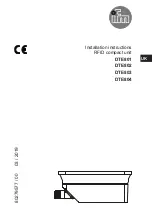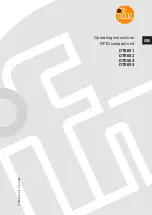
2. Settings
3. Function test
The control unit is preset, i.e. If you require another
setting, you will have to implement this either with the
aid of the buttons of the 7-segment display on the
control unit (see adjustment instructions),
or via the PDA.
All connected sensors must be checked in every
program switch position.
The
must be set according to the respective
installation instructions/documentation texts.
The safety beams are automatically tested before
each closing cycle. If the test fails (the door does not
close) the system must be checked by a service
engineer.
The passage between the sliding leaves is monitored
by safety beams . If a person or an object enters the
passage or detection range of the safety beams, a
closing cycle is reversed to an opening cycle and the
door remains open until the monitored area is free and
the hold-open time has expired.
Interrupt one safety beam after the other during the
closing cycle.
The respective LED on the control unit goes out
and the door reverses.
Interrupt the safety beams for several seconds while
the door is open.
The door should remain open for as long as the
safety beams are interrupted.
Once the safety beams are uninterrupted,
the door should close on expiry of the preset
hold-open time.
Activation sensors are mostly radar sensors
responding to movements. The system is activated by
approaching people or objects.
Basic requirements:
The external activation sensor is connected and the
program switch is set to AUTOMATIC or
PARTIAL OPEN position.
Function:
If a person or an object a ects the range of the sensor,
the door opens, and then closes on expiry of the hold-
open time.
Please note:
3.1 Safety beams (Optional-not required)
Automatic safety beam self-check
(internal test via control unit)
Manual safety beam check…
During closing cycle:
While the door is open:
3.2 External activation sensor
Function test.
sensors
·
·
·
3.3 Internal activation sensor
Function test.
Basic requirements:
Function:
3.4 Night-/ Bank Function
Function test.
Basic requirements:
Function:
3.5 Breakout Switch
Basic requirements:
Function:
3.6 Locking device
3.7 Monitoring of closing and opening force
Obstruction during closing cycle:
If the door leaves run up against an obstruction during
the closing cycle, the closing cycle is reversed into an
opening cycle. The door opens to its full width. The
door then closes at low (creep) speed until the hold
open time expires. This sequence is repeated until
the obstruction is removed.
Obstruction during opening cycle:
Function test.
The internal
must be connected and
the program switch must be set to AUTOMATIC,
EXIT ONLY or PARTIAL OPEN position.
If a person or an object a ects the detection range of
the sensor, the door opens, and then closes on expiry
of the hold-open time.
The Night-/ Bank contact is connected and the
program switch is set to
CL
O
SE
.
Activate the system with the
.
The door is unlocked and opens.
Once the user has passed the door or on expiry
of a
d hold-open time, the door closes and
locks in the closed position.
The program switch must be set to AUTOMATIC,
PARTIAL OPEN, EXIT ONLY,
CL
O
SE
(not locked) or
PERMANENT OPEN.
Breakout any panel.
The door leaves stop immediately
The door can be moved manually.
The door is in close position, it is locked, when the
program switch is set to OFF, AUTOMATIC or
EXIT ONLY.
If the door leaves open against an obstruction, the
door stops, then performs a further opening attempt at
low (creep) speed. If the obstruction is still present, the
door stops again. After a total of six opening attempts
the door closes. Once the obstruction is removed, the
next opening cycle is performed at low (creep) speed.
Then the door resumes operation at the preset speed.
activation sensor
Night-/ Bank contact
·
·
·
·
ESA II Controller
and Wiring Manual
DORMA
4
DORMA AUTOMATICS, Inc.
924 Sherwood Drive
Toll-Free: 877-367-6211
DL2842-010
Lake Bluff, IL 60044
Fax: 877-423-7999
rev. A
E-mail: [email protected]
Subject to change without notice






































